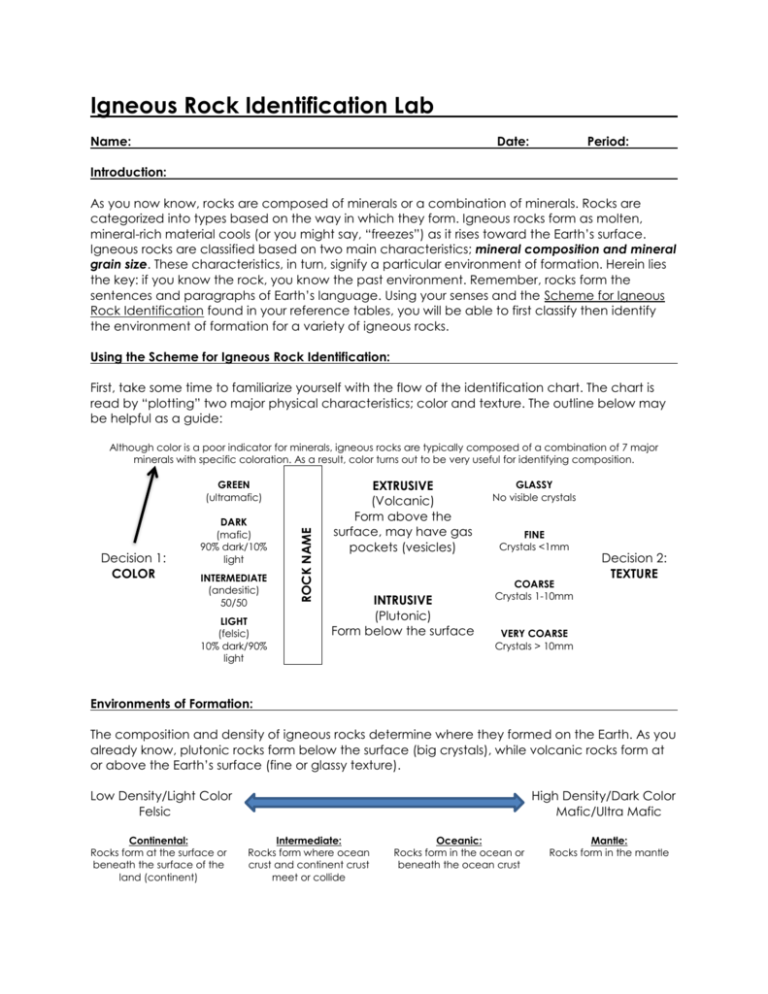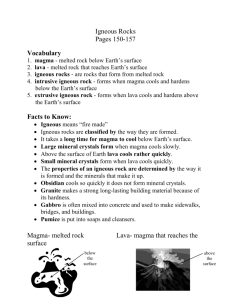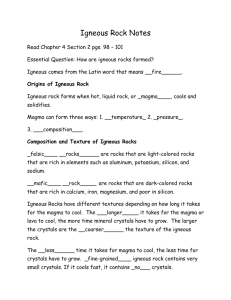File
advertisement

Igneous Rock Identification Lab Name: Date: Period: Introduction: As you now know, rocks are composed of minerals or a combination of minerals. Rocks are categorized into types based on the way in which they form. Igneous rocks form as molten, mineral-rich material cools (or you might say, “freezes”) as it rises toward the Earth’s surface. Igneous rocks are classified based on two main characteristics; mineral composition and mineral grain size. These characteristics, in turn, signify a particular environment of formation. Herein lies the key: if you know the rock, you know the past environment. Remember, rocks form the sentences and paragraphs of Earth’s language. Using your senses and the Scheme for Igneous Rock Identification found in your reference tables, you will be able to first classify then identify the environment of formation for a variety of igneous rocks. Using the Scheme for Igneous Rock Identification: First, take some time to familiarize yourself with the flow of the identification chart. The chart is read by “plotting” two major physical characteristics; color and texture. The outline below may be helpful as a guide: Although color is a poor indicator for minerals, igneous rocks are typically composed of a combination of 7 major minerals with specific coloration. As a result, color turns out to be very useful for identifying composition. Decision 1: COLOR DARK (mafic) 90% dark/10% light INTERMEDIATE (andesitic) 50/50 LIGHT (felsic) 10% dark/90% light ROCK NAME GREEN (ultramafic) EXTRUSIVE (Volcanic) Form above the surface, may have gas pockets (vesicles) INTRUSIVE (Plutonic) Form below the surface GLASSY No visible crystals FINE Crystals <1mm COARSE Crystals 1-10mm Decision 2: TEXTURE VERY COARSE Crystals > 10mm Environments of Formation: The composition and density of igneous rocks determine where they formed on the Earth. As you already know, plutonic rocks form below the surface (big crystals), while volcanic rocks form at or above the Earth’s surface (fine or glassy texture). Low Density/Light Color Felsic Continental: Rocks form at the surface or beneath the surface of the land (continent) High Density/Dark Color Mafic/Ultra Mafic Intermediate: Rocks form where ocean crust and continent crust meet or collide Oceanic: Rocks form in the ocean or beneath the ocean crust Mantle: Rocks form in the mantle Rock Type 1. Igneous 2. Igneous 3. Igneous 4. Igneous 5. Igneous 6. Igneous 7. Igneous 8. Igneous 9. Igneous 10. Igneous 11. Igneous 12. Igneous Color (dark w/ green, dark, Intermediate, light) Magma Type: (Mafic, Felsic, or in Between) Texture: (Glassy, Fine, Coarse, Very Coarse, Vesicular/Non) Where Formed: (Intrusive or Extrusive) Environment: (Mantle, Ocean, Intermediate, Continental) Rock Name: Analysis Questions: 1. What does the color of an igneous rock tell you? What are some rocks similar in color: 2. In magma that cools slowly, the crystals of the minerals have along time to grow. In lava that cools quickly, the crystals do not have much time to grow and may not form at all. Are the crystals in rocks that cooled slowly larger or smaller than the crystals in rocks that cooled quickly? 3. In magma that cools below ground it is insulated by the surrounding rock. Will it cool quickly or slowly? Which rock numbers cooled below ground? 4. When lava cools on the surface, heat can escape quickly to the atmosphere. Which rock numbers cooled above ground? 5. The pumice, scoria, and obsidian have no crystalline structure at all. Do they form slowly or very quickly? Why do you think scoria an pumice have so many holes? 6. What determines the type of igneous rock that forms when magma or lava cools?








